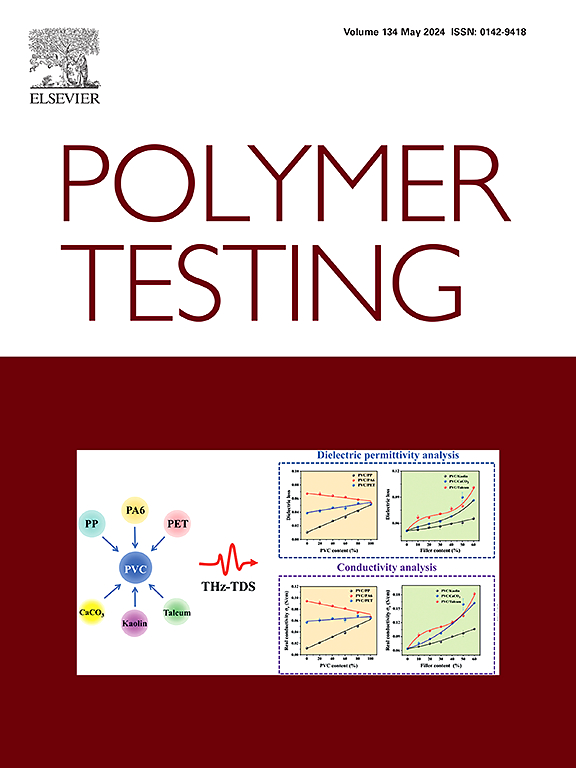Unlocking the potential of graphene films embedded within 3D woven glass fiber reinforced composites for enhanced damage protection
IF 6
2区 材料科学
Q1 MATERIALS SCIENCE, CHARACTERIZATION & TESTING
引用次数: 0
Abstract
This study employs a novel co-curing approach to fabricate 3D glass fiber reinforced polymer (GFRP) composites with enhanced damage tolerance by incorporating graphene nanoplatelet (GNP) surfacing films. Low-velocity impact (LVI) tests were conducted on four different samples: pristine GFRP and GFRP composites with 1 wt%, 2 wt%, and 5 wt% GNP surfacing films co-cured with the laminate during resin infusion. The impact tests were performed at energy levels of 20 J, 30 J, and 50 J using a 6.20 mm diameter impactor. Moreover, a flexure-after-impact (FAI) test was also performed to assess the effects of impact-induced damage on the residual strength of LVI samples. The LVI and FAI results demonstrated that 2 wt % GNP-GFRP composites exhibited slightly better damage performance compared to the pristine GFRP composite. This improvement in LVI and post-FAI performance is attributed to the toughening effect of the 2 wt % GNP surfacing film and the enhanced interfacial adhesion between the co-cured GNP film and the 3D GFRP composite. Additionally, short beam shear testing was conducted to evaluate the interlaminar shear strength (ILSS) of the films with the composites. Notably, the ILSS of the 2 wt% GNP-GFRP composite improved by 10 % compared to the pristine GFRP composite. These findings suggest that incorporating GNP surfacing films is a promising strategy for damage-resistant structures in aerospace applications.
释放石墨烯薄膜嵌入3D编织玻璃纤维增强复合材料的潜力,增强损伤保护
本研究采用一种新型共固化方法,通过添加石墨烯纳米血小板(GNP)表面膜来制备三维玻璃纤维增强聚合物(GFRP)复合材料,增强其损伤容忍度。在四种不同的样品上进行了低速冲击(LVI)测试:原始GFRP和GFRP复合材料,在树脂注入过程中,表面膜与层压板共固化,分别为1 wt%、2 wt%和5 wt% GNP。使用直径6.20 mm的冲击器,在20 J、30 J和50 J的能量水平下进行冲击试验。此外,还进行了冲击后挠曲(FAI)试验,以评估冲击损伤对LVI样品残余强度的影响。LVI和FAI结果表明,与原始GFRP复合材料相比,2%的GNP-GFRP复合材料的损伤性能略好。这种LVI和fai后性能的改善归因于2 wt % GNP表面膜的增韧作用以及共固化GNP膜与3D GFRP复合材料之间的界面附着力增强。此外,还进行了短束剪切试验,以评估复合材料薄膜的层间剪切强度(ILSS)。值得注意的是,与原始GFRP复合材料相比,2% GNP-GFRP复合材料的ILSS提高了10%。这些发现表明,结合GNP表面膜是航空航天应用中抗损伤结构的一种有前途的策略。
本文章由计算机程序翻译,如有差异,请以英文原文为准。
求助全文
约1分钟内获得全文
求助全文
来源期刊

Polymer Testing
工程技术-材料科学:表征与测试
CiteScore
10.70
自引率
5.90%
发文量
328
审稿时长
44 days
期刊介绍:
Polymer Testing focuses on the testing, analysis and characterization of polymer materials, including both synthetic and natural or biobased polymers. Novel testing methods and the testing of novel polymeric materials in bulk, solution and dispersion is covered. In addition, we welcome the submission of the testing of polymeric materials for a wide range of applications and industrial products as well as nanoscale characterization.
The scope includes but is not limited to the following main topics:
Novel testing methods and Chemical analysis
• mechanical, thermal, electrical, chemical, imaging, spectroscopy, scattering and rheology
Physical properties and behaviour of novel polymer systems
• nanoscale properties, morphology, transport properties
Degradation and recycling of polymeric materials when combined with novel testing or characterization methods
• degradation, biodegradation, ageing and fire retardancy
Modelling and Simulation work will be only considered when it is linked to new or previously published experimental results.
 求助内容:
求助内容: 应助结果提醒方式:
应助结果提醒方式:


